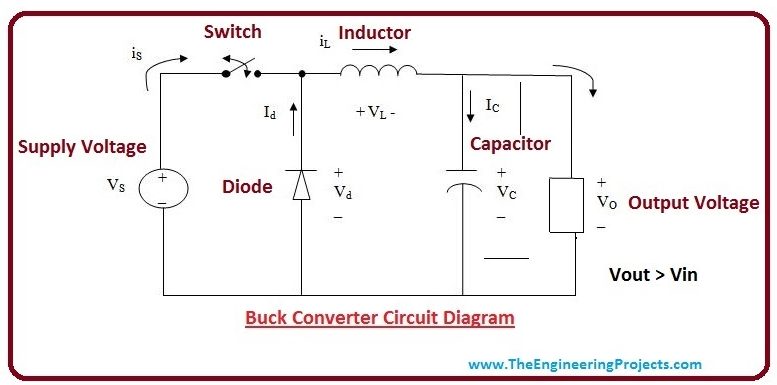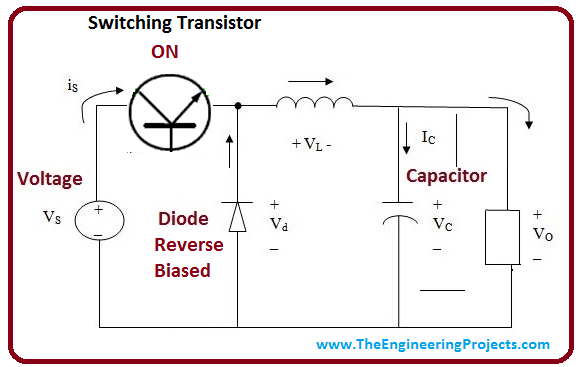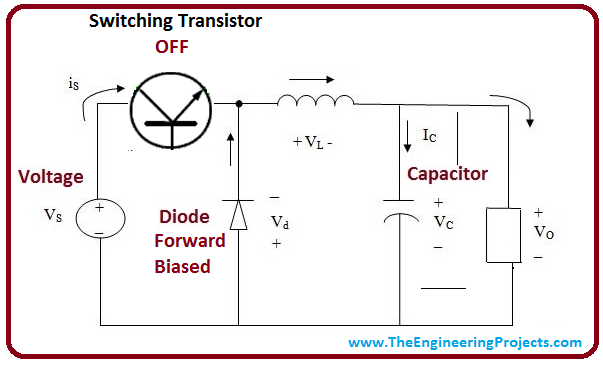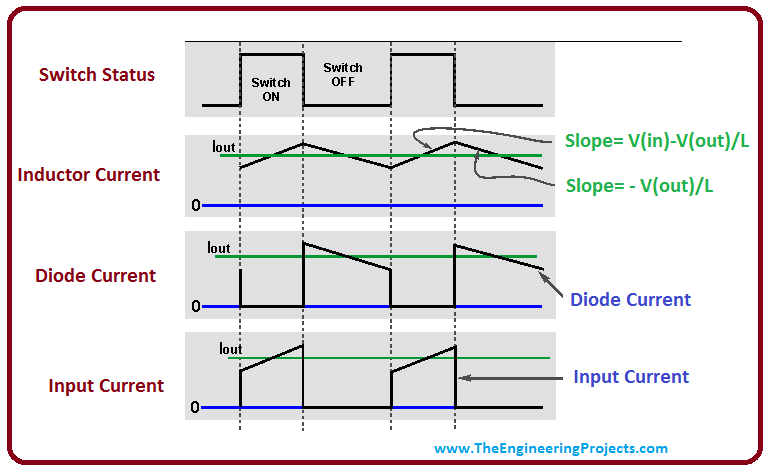
Introduction to Buck Converter
- Buck converters are power converters which are mainly used for converting high voltage to the low voltage. These converters are highly efficient, showing almost 90% of efficiency.
- They are useful for performing a special task like converting the huge supply voltage of 12 V in the computer to 1.8 V for making it useful for operating small components like USB, CPU, and DRAM.
- Transistor used in buck converter act as a switching device. Obtaining a continuous output is the main purpose of buck converter which can be achieved by using the energy stored in the capacitor.
- Transistor switches between on and off at high frequency. Energy stored in the capacitor is mainly used in the buck converter during the off condition of the transistor, making it useful for obtaining a continuous output.
- Circuit diagram of a buck converter is given below:

- Buck converter is mainly called as a DC to DC converter. Source input can either be obtained directly from DC source or from rectified AC source.
- After getting DC source, it is passed through a switching transistor which converts it AC source. Eventually, the AC source is converted to DC source at the output voltage.
1. Buck Converter Working Principle
- Buck converter consists of switching transistor, diode, and energy storing elements such as capacitor or inductor. Transistor switches between on and off continuously. When the transistor switch is turned on, it is denoted by T(on) and when it is turned off, it is denoted by T(off). Duty cycle can be obtained by the dividing the time when switch is turned on with the total time of the cycle
D = T(on)/T
- Inductors works in both ways i.e. it opposes the current from changing its direction and also as an energy storing element. Energy is stored in the inductor which prevents the output from getting too high and that energy is released when the transistor is switched to off condition.
If Transistor is Switched ON
- When transistor is switched on, current will flow from the inductor L. Current flowing through the load is being restricted by the inductor and a surplus amount of energy will be stored in the inductor. Circuit diagram of a buck converter is shown in the figure given below when the transistor is switched on.

- The diode which is reverse biased won't take part in the operation of the buck converter as there is large positive voltage appear to the cathode part of the diode. When the switch is closed the voltage across inductor will be
V(Inductor) = V(in) - V(out)
- The capacitor using in this circuit diagram will continuously charge up to the maximum value and releases its energy when the transistor switches to off condition.
If Transistor is Switched OFF
When transistor switches to off condition, the diode available in the buck converter turns to forward biased, making its cathode negative and anode side positive. Circuit diagram of the buck converter is shown in the figure given below when transistor is switched off.
- When transistor is switched off, the inductor will automatically change its polarity with respect to the polarity given in transistor on condition. Now, the voltage across the inductor is also called back emf and it will give its energy back to the circuit during off condition. Here V(inductor) = - V(out)
- Sometimes we need minimum output at the output voltage, in this case, current flowing through the inductor becomes zero. When it falls below zero, it results in automatically discharing the capacitor energy which is stored when the transistor is operated in on condition. When capacitor is completely discharged, it automatically erupts the high switching losses. Pulse frequency modulation is used to avoid such losses.
- The average value of energy stored in inductor will always remain same at the end of the cycle.
- When output begins to fall, the only source of energy will be the energy from the capacitor, causing the current to flow through load and also preventing it from going too high.
- We get the output in the ripple form, instead of getting in square form. And can be defined as
V(out) = V(in) * T(on)/ T
Here T(on) is a time duration of the cycle when the transistor is on and T is the total time of the cycle.-
- Ripple formed in buck converter shows that voltage goes high at the on state and drops down at off state.
2. Examining the current waveform during overall cycle
Let us examine the current wave form of diode current, inductor current and input current during overall cycle.
- During whole cycle input current will be much less than the output current, resulting in stepping down the voltage at the output. Notice that, assuming the ideal conditions, the overall power of the cycle will remain constant. i.e. V(in)*I(in) = V(out)*I(out)
- However, getting perfect circuit is not possible in reality due to some energy losses. Maximum efficiency that practical buck converters exhibit is about 85%.
3. Applications of Buck Converters
Buck converters exhibit a wide range of application depending on its efficiency and durability. Some of its main applications are given below.USB ON-the-GO
USB On-the-GO is mainly used for connecting the mouse, keyboard and other useful devices to the smartphone. The main purpose of buck converter using in USB is to draw power from the USB and delivers it to the smartphone. Hence, it is the main source of regulating the power in both directions.- When smartphone is plugged into charging, the buck converter is used to charge the lithium battery inside the smartphone,
- When some mice or keyboard is connected to the smartphone, buck converter works in a reverse order and draws power from the lithium battery and delivers it to the keyboard or mouse connected to the smartphone.
POL (Point of Load) converter for Laptops
- POL, also known as a voltage regulator, is a converter that is widely used in laptops and desktop computers. It is very useful in operating the motherboard at low voltage.
- Compressors are very delicate devices fixed in the laptops and even a fraction of the increase in voltage can damage its overall performace and quality. So, buck converter in the laptops does its job very nicely by maintaining the voltage in the processor as low as 1.8V.
Solar Chargers
- Buck converters are widely used in solar chargers. They often come with a built-in microcontroller which allows the buck converter to draw maximum power and helps in charging the battery in limited time possible.
Quad-copters
- Quad-copters come with a highly efficient buck converter for dropping down the input voltage. Quad-copter mostly uses DC power supply such as small batteries which are placed in a series. Normally 5 to 6 batteries are used to make quad-copter fully operational. These batteries provide voltage that ranges between 6 to 25 V.
- Buck converter in the batteries converts that voltage to 3.3 V for making it useful for flight controller which is a backbone of quad-copter.



